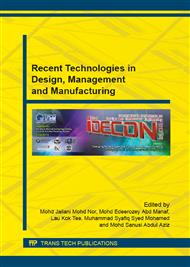p.631
p.636
p.641
p.646
p.651
p.659
p.664
p.668
p.673
The Implementation of Genetic Algorithm in the Manufacturing Process of a Product for Reduced Environmental Impact: A Case Study of a Pulley Crankshaft
Abstract:
Life Cycle Assessment or LCA method is believed to be a good solution to improve sustainability in a manufacturing process. This method allows designers to identify opportunities to improve the environmental aspects of products at various points in their life cycle. In this paper, the implementation of LCA through the development of an Environmental Impact Assessment Tool (EIAT) is demonstrated via a case study of Volkswagen pulley crankshaft. EIAT is a tool that aids designers to improve the environmental impact in a manufacturing process by designing or producing products with minimal environmental impact and minimal use of resources, such as the material and energy. EIAT also offers the optimization of design solutions to reduce potential environmental impact of a specific product according to its design features. A pulley crankshaft was modelled in a CAD system where the form is fixed to maintain its function. Pulley crankshaft features, such as the type of material, diameter of pocket, stock thickness and diameter are the parameters that were optimized through the Genetic Algorithm encoded in EIAT. EIAT was validated with Eco-It (an established LCA tool) and with actual experiments. Results show a difference of less than 9% error between EIAT with the results produced by Eco-It and the actual experiments.
Info:
Periodical:
Pages:
651-655
Citation:
Online since:
May 2015
Authors:
Price:
Сopyright:
© 2015 Trans Tech Publications Ltd. All Rights Reserved
Share:
Citation:


